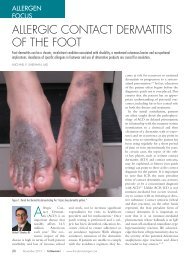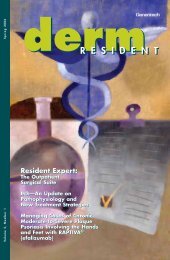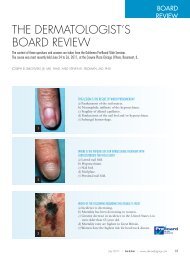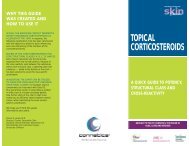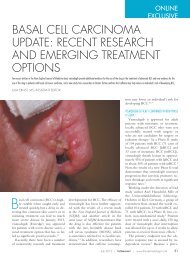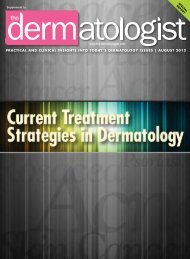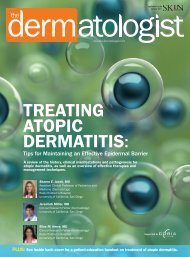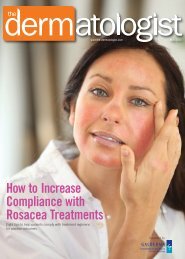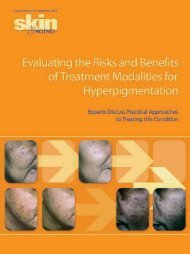<strong>Oat</strong> <strong>Oil</strong> <strong>Improves</strong> <strong>the</strong> <strong>Skin</strong> <strong>Barrier</strong><strong>Oat</strong> oil is rich in linoleic acid, which is an essential polyunsaturated fatty acid critical for <strong>the</strong> maintenance of <strong>the</strong> skin permeability barrier.Michael Southall, PhD, Apostolos Pappas, PhD, Glenn Nystrand, BS, Judith Nebus, MBAJohnson & Johnson Consumer Companies, Inc.<strong>The</strong> outermost layer of <strong>the</strong> epidermis, <strong>the</strong> stratumcorneum, functions as a two-way physical andchemical barrier: it prevents both <strong>the</strong> penetration ofnoxious agents from <strong>the</strong> environment into <strong>the</strong> skin and<strong>the</strong> evaporation of water in <strong>the</strong> opposite direction. <strong>The</strong>stratum corneum is formed by corneocytes and intercellularlipids (lamellae), which contain mostly ceramides(50% of <strong>the</strong> stratum corneum lipid mass), cholesterol(25%) and free fatty acids (10%). 1,2 <strong>The</strong> specific mixtureand organization of <strong>the</strong>se lipids in <strong>the</strong> space betweencorneocytes allows <strong>the</strong> proper maintenance of <strong>the</strong> permeabilitybarrier. <strong>The</strong> significance of ceramides for <strong>the</strong>stratum corneum barrier has been extensively reportedand <strong>the</strong> essential fatty acid (EFA) linoleic acid (LA), containedin ester linkage in acylceramides (ceramide fractions),seems particularly important for <strong>the</strong> normal barrierfunction. 2An alteration in stratum corneum lipids has beenidentified in several skin disorders with damaged permeabilitybarrier, including atopic dermatitis (AD). Acompromised barrier increases <strong>the</strong> penetration of irritants,allergens and pathogens, thus causing or fur<strong>the</strong>ringskin inflammation. 3,4 A defective barrier is not only akey feature of AD, but <strong>the</strong> degree of skin barrier damagecorrelates with <strong>the</strong> disease severity. 5 For this reason,emollients that repair and protect <strong>the</strong> stratum corneumare important for <strong>the</strong> general skin health as well as for <strong>the</strong>improvement of certain eczematous conditions. 4Linoleic Acid and <strong>Skin</strong> <strong>Barrier</strong>LA is one of <strong>the</strong> most significant lipids for <strong>the</strong> maintenanceof barrier function. 6 In fact, recent studies suggestthat LA is essential for <strong>the</strong> formation of <strong>the</strong> lamellarphase of <strong>the</strong> stratum corneum lipids. 2,7 Additionally,studies showed that stratum corneum free fatty acids,including LA, are important for <strong>the</strong> maintenance of <strong>the</strong>surface “acid mantle,” which, in turn, seems importantfor both <strong>the</strong> integrity of <strong>the</strong> permeability barrier andstratum corneum cohesion. 8<strong>The</strong> importance of LA for a healthy skin barrier hasbeen known since <strong>the</strong> 1930s, when pre-clinical experimentsdemonstrated that a prolonged fat-free diet wouldlead to severe scaly dermatosis and a significant increasein transepidermal water loss (TEWL), and that oral intakeof LA would reverse <strong>the</strong>se symptoms. 9 Humanclinical studies have subsequently confirmed <strong>the</strong> reversalTable 1. Lipid Class (%) composition in <strong>the</strong> oat oil oftriple oatLipid Class %Triglycerides 83.4Free Fatty Acids 6.8Diacylglycerols 8.9Phospholipids 0.9Triglycerides are <strong>the</strong> most abundant lipids in oat oil. <strong>The</strong> fatty acids oleic acid (OA) and linoleicacid (LA) are contained in various percentages in each of <strong>the</strong> four lipid classes (35% to 43% forOA and 36% to 45% for LA).of <strong>the</strong> cutaneous manifestation of EFA deficiency afterconsumption of LA-rich diet. 10 Since <strong>the</strong>n, studies haveshown skin barrier improvement also via topical applicationof LA or of oils rich in LA (eg, sunflower seedoil). 11,12 In 1975, Prottey et al demonstrated decreasedscaliness and decreased TEWL (ie, improved barrier)in EFA deficient patients treated for 2 weeks with sunflower-seedoil applied to <strong>the</strong> forearms; interestingly,improvement did not occur in <strong>the</strong> contralateral forearmtreated with olive oil, rich in oleic acid. 11In preclinical studies, topical LA-rich oils were alsoshown to improve <strong>the</strong> skin barrier in EFA deficiencymodels or in skin disrupted by sodium laurate; in bothgroups, skin applications of sunflower seed oil normalized<strong>the</strong> high TEWL. 12 Interestingly, linoleic acid from<strong>the</strong> sunflower seed oil application was detected in <strong>the</strong>epidermal lipids of <strong>the</strong> EFA deficient group. 12 A laterstudy by Elias et al 6 confirmed <strong>the</strong>se results: in an EFAdeficient preclinical model, <strong>the</strong> application of pure LAto <strong>the</strong> skin quickly improved <strong>the</strong> barrier function (decreasedTEWL), while contralateral application of pureoleic acid produced deterioration of <strong>the</strong> skin barrier(increased TEWL). In fact, pure oleic acid, in its unbound,free fatty acid form, has been shown to actuallyincrease <strong>the</strong> skin permeability by disrupting <strong>the</strong> lamellarlipid arrangement in <strong>the</strong> stratum corneum and thusfunctioning as a penetration enhancer. 13,14 It is importantto note, though, that <strong>the</strong> vast majority of oleic componentsin vegetable oils are present in esterified and boundforms. Topical formulations, containing vegetable oils,are designed with additional stabilization to maintain <strong>the</strong>structure of <strong>the</strong> emulsion, to normalize <strong>the</strong> pH rangeand to prevent microbial growth. All of <strong>the</strong>se factors are2 September 2012 • Supplement to <strong>The</strong> <strong>Dermatologist</strong> ®
<strong>Oat</strong> <strong>Oil</strong> <strong>Improves</strong> <strong>the</strong> <strong>Skin</strong> <strong>Barrier</strong>Table 2. Fatty acid (%) composition in <strong>the</strong> oat oil of triple oatPhospholipid Diacylglycerol Free Fatty Acid TriglyceridesPalmitic 16:0 12.9 15.3 16.7 14.7Stearic 18:0 3.2 2.3 1.9 1.6Oleic 18:1 (n-9) 35.0 42.9 38.3 42.7Linoleic 18:2 45.3 36.1 39.2 37.0<strong>The</strong> majority of fatty acids are esterified in <strong>the</strong> triglyceride fraction of oat oil.beneficial for maintaining <strong>the</strong> quality of <strong>the</strong> vegetable oilin <strong>the</strong> formulation.<strong>The</strong> importance of lipid emulsions containing LA inrepairing <strong>the</strong> barrier function has been highlighted in afew studies. A recent study investigated <strong>the</strong> barrier repairability of two topical emulsions containing a mixture oflipids, after <strong>the</strong> skin was damaged by sodium lauryl sulfate(SLS). 15 <strong>The</strong> emulsion containing LA in combination withceramides III, IIIB, VI, phytosphingosine and cholesterolproduced a significantly faster barrier recovery comparedto <strong>the</strong> emulsion containing only ceramides III and IIIB.<strong>Oat</strong><strong>Oat</strong> is a natural agent that contains a variety of activecompounds, including: lipids with a high percentage ofunsaturated fatty acids, starches and hydrocolloid β-Dglucan,avenanthramides and o<strong>the</strong>r antioxidants (mostlyphenolic esters), saponins and vitamins. 16,17 <strong>The</strong> total lipidcontent is relatively high (around 6% to 12% in groats)compared to o<strong>the</strong>r cereals; of <strong>the</strong> groat lipids, about 41%are triglycerides and 5% free fatty acids. 18 <strong>Oat</strong>s are particularlyrich in unsaturated fatty acids, with polyunsaturatedLA (18:2) and monounsaturated oleic acid (18:1)accounting for approximately 40% and 36% (averages) of<strong>the</strong> total groat fatty acid pool, respectively. 18 O<strong>the</strong>r fattyacids include palmitic acid (16:0, about 19%) and minimalamounts of linolenic, stearic and myristic acids. 18 Itshould be noted, though, that <strong>the</strong> percentages of oat oilfractions reported in <strong>the</strong> literature vary depending oncultivars, storage and extraction method. 18<strong>The</strong> chemical polymorphism of oats is at <strong>the</strong> basis of<strong>the</strong>ir multiple beneficial effects, including barrier protection,moisturization, anti-inflammatory, soothing, cleansing,etc. For decades, oat-containing emollients have beenused in various eczematous conditions and recent studieshave confirmed <strong>the</strong>ir importance in <strong>the</strong> treatmentof AD 19-21 and xerosis. 22 <strong>Oat</strong> is currently used in topicalformulations ei<strong>the</strong>r as colloidal oatmeal or as its separatedfractions. Colloidal oatmeal is derived from <strong>the</strong> wholedehulled grain and is categorized as an over-<strong>the</strong>-counter(OTC) skin protectant drug, regulated by <strong>the</strong> FDA. 23 Additionalrecent investigations have focused on <strong>the</strong> specificbiological effects of active compounds extracted from oat,such as avenanthramides and oat oil. Avenanthramides arephenolic molecules that have shown potent anti-inflammatoryactivity both in vitro and in vivo. 17 <strong>Oat</strong> oil hasalso been recently studied for its beneficial dermatologicaleffects and it is likely that its LA fraction plays a major rolein <strong>the</strong> maintenance of <strong>the</strong> epidermal water barrier. 24<strong>Oat</strong> <strong>Oil</strong> ExperienceIn view of its potential benefits, oat oil has been recentlyincorporated in new topical products. In this article,we review a novel moisturizer formulated with amixture of three active oat compounds (triple oat): colloidaloatmeal, avenanthramides and oat oil. Each oatingredient is carefully sourced to ensure quality andconsistency. <strong>The</strong> specific oat crop, used in <strong>the</strong> manufactureof this oat oil, is grown from selected soils in aparticular region of northwestern Europe, virtually freeof <strong>the</strong> risk of pollution. Additionally, <strong>the</strong> extracted oatoil is carefully processed to retain its biologically activecompounds and its quality is assured through standardizationof extraction procedures with non-toxic solventsand relatively low temperatures.<strong>The</strong> oat oil in triple oat contains more than 70% unsaturatedfatty acids. LA, in particular, constitutes approximately37% of <strong>the</strong> total fatty acid fraction, presentin part as free fatty acid, and in part esterified tovarious lipids (mostly triglycerides) (Tables 1, 2). <strong>The</strong>high phospholipid content and relatively high unsaturatedfatty acid content found in oat oil are very differentfrom o<strong>the</strong>r natural oils. Most extracted natural oils (eg,olive oil) are primarily composed of triglycerides, withno phospholipids, and very few fatty acids.A 2-week study was performed to evaluate <strong>the</strong> effectivenessof a triple oat lotion (colloidal oatmeal, oat oiland oat extract) on individuals with mild to moderate itchdue to extra dry skin on <strong>the</strong> lower legs. Twenty-nine patientsapplied <strong>the</strong> triple oat lotion twice a day for 2 weeks.Clinical evaluations demonstrated significant improvements(p



